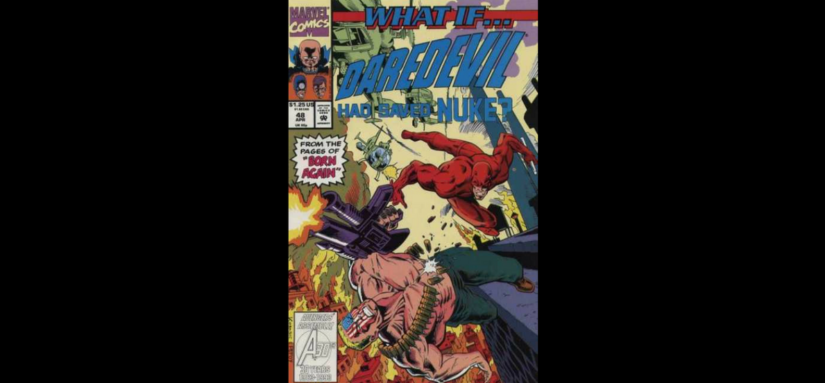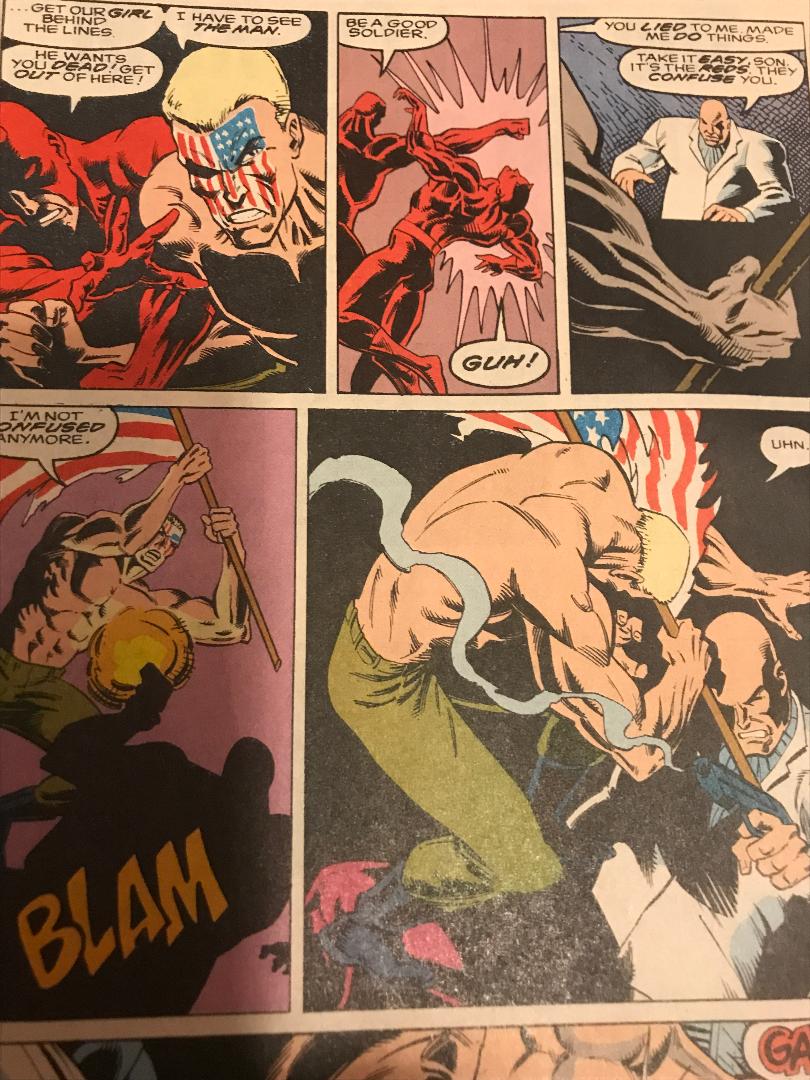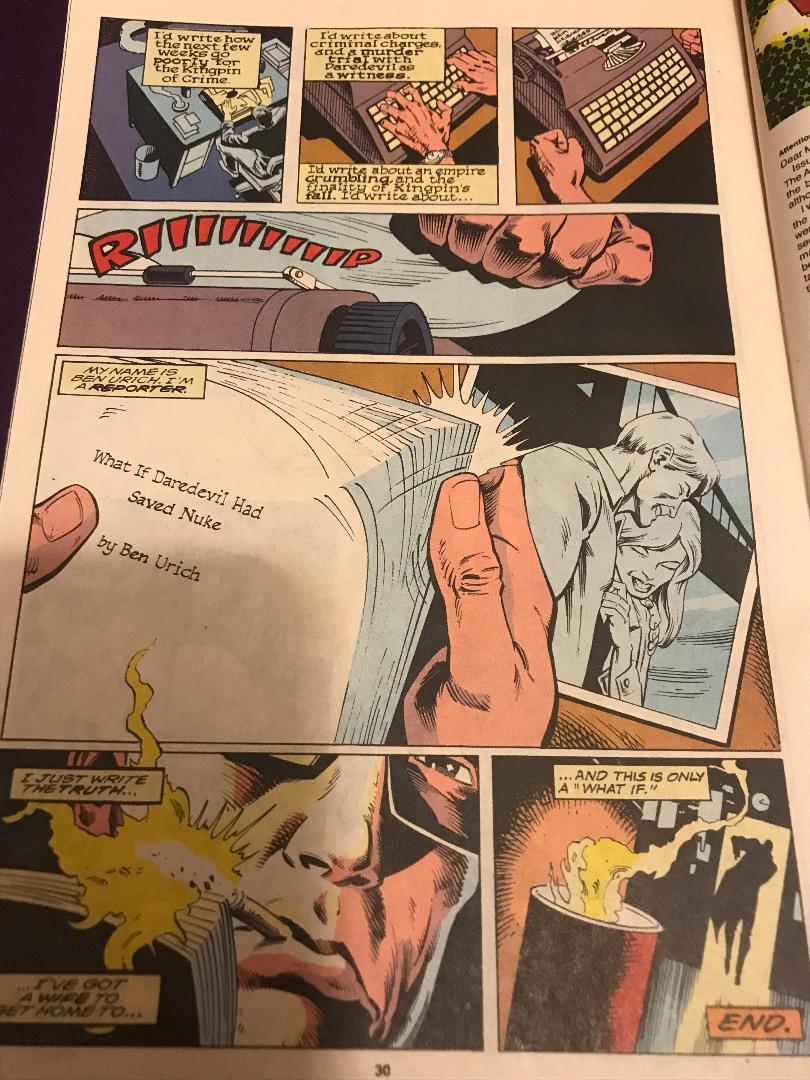This is my ninth and final article of 2017 for Blastoff!, and before we get down to the nitty gritty, I want to take a moment to shout out my longtime pal, Professor Scott Tipton, for inviting me to contribute to the site this past January. I’m proud to be affiliated with the site, I appreciate the feedback, the retweets, the shares on Facebook, and everyone who has taken a few minutes out of their day to read one of these columns or tell a friend.
Thanks to the Professor, my fellow contributors, and to all of you. It’s been fun.
Hope to see you all in 2018!
______________
“Well, I don’t wanna be a rich man mama, I don’t wanna cry /
Well, I don’t wanna be a poor man mama, I don’t wanna fly /
Well, I don’t wanna be a lawyer mama, I don’t wanna lie /
Well, I don’t wanna be a soldier mama, I don’t wanna die….”
-Lyrics from “I Don’t Wanna Be a Soldier, Mama” by John Lennon, from the album Imagine.
Marvel’s What If… Issue #48 is an interesting little piece of business. “What if…Daredevil had saved Nuke?” feels like a grimy little pebble that was skimmed over the surface of the 90s era Marvel Universe. It’s a quick read, almost deceptively slight in build, and fast-paced like a flashy action flick, but don’t let that fool you. Under the surface there’s a bit more going on, and it’s oddly relevant with everything going on in our world today under the current administration. PTSD, drug addiction, obsessive relationships, nationalism, even the corporate stranglehold on journalism, are represented in this comic book. I never expected that when I revisited What If… #48 (bearing a publication date of April, 1993). If you needed it, here’s proof that sometimes you can find the coolest little surprises when thumbing through long boxes of old issues with little to no expectations.
Allow that cover art to sink in. Amidst a garish blast of high fructose frenzy and Jerry Bruckheimer/Don Simpson over-the-top testosterone, we have Daredevil lunging from the edge of a high rise toward “Nuke.” This character, “Nuke,” is a shirtless, muscle-bound, American flag face paint-wearing freak, a hybrid of World Championship Wrestling hero Sting and Universal Soldier’s Dolph Lundgren. Hero and villain are surrounded by hovering choppers, closing in from dizzying angles while Hell’s Kitchen burns below.
Nothing subtle here, folks. This cover screams at you with the volume turned up to full blast. It’s deafening, jumping out at you from the spinner racks like a desperate puppy at the pet shop, begging you to pick it up and take it home.
For what it is, I believe it’s quite stunning. It’s unabashedly proud and loud and you know what? It did the trick. Not only did I buy it when I was a kid, but I held onto it all these years later. For me, at that time in my life, it ticked all the right boxes. In other words, I judged the book by its cover, and forked over my buck twenty-five. Did I get my money’s worth? We’ll explore that right now.
When you’re dealing with “What If” and “Elseworlds”-type titles, you often have to make a leap of faith. As opposed to a run of comics by familiar creators who’ve won you over, or a character who you’ve invested your time into, sometimes following their adventures for years regardless of the current creative team, “What If” and “Elseworlds” books are ones that you might cherry pick. Okay, some of you may buy every issue of What If… for example, like someone who watches every episode of an anthology series on TV, but there are others out there who may be limited with their disposable income (read: my weekly allowance as a kid). Or maybe you’re just not a fan of whatever character is being featured that particular month and decide to sit one out. It was the ‘90s after all, with so many publishers and books trying to gain your attention (and dollars); no one will hold it against you if you didn’t read What If…#48.
I don’t recall what happened in issue #47 of What If… and I don’t know what happened in issue #49 (and the nice thing as a reader about these types of series is they allow you to bounce around), but issue #48? Yeah, not ashamed to admit that the cover sold me. That cover is credited to penciler Kevin Kobasic and inker Andrew Pepoy, who both handled the respective duties for the interiors.
The story for issue #48 of What If… is brought to us by writer Ron Marz. It’s gritty, pulpy, and an expertly crafted standalone tale that may have slipped under your radar. It piggybacks off story elements from the “Born Again” saga, but Marz does such a deft job summarizing how that series unfolded during a single page of issue #48 of What If… that, if you weren’t familiar with “Born Again,” it wouldn’t prevent you from appreciating this story. Marz has you covered. It was the 90s after all, with so many publishers and books trying to gain your attention (and dollars); no one will hold it against you if you didn’t read What If… #48.
Let’s get to that story. It’s told to us from the point of view of Ben Urich, reporter for the Daily Bugle. It’s a bit meta, with Urich shown pecking away at his Underwood, setting up the narrative, essentially asking “What if?” What if the events of “Born Again” unfolded differently? What if everything you read there had an alternate ending? What if…Daredevil had saved Nuke?
The first page opens with a series of captions:
“The newsprint won’t come off. It stains your hands and your wife never lets you touch the new white sheets on the bed.”
Urich continues: “You dig and dig and dig to uncover a car dealer’s criminal ties, and the story gets killed because he’s a good advertiser.
“It’s no good. Most of the time.
“But you hold on for one story. One that makes a difference.”
There are mature themes presented here, with a political undercurrent that would have been lost on me when I was a kid. Back then, I just wanted to see how Daredevil was going to handle Nuke on the rooftop, without getting his own goose cooked in Hell’s Kitchen. Revisiting this as an adult, it’s impressive to see how Marz laced the story with a rather cynical worldview. Keep in mind, we weren’t too far removed from the Gulf War, and everything that that encompassed, whether it was the rise in popularity of 24-hour network news, which gleefully replayed the grainy black and white footage from Smart Bombs hitting their targets, or Desert Storm trading cards. (“Hey Georgie, I’ll trade you this Scud Missile card for your extra “Stormin’” Norman Schwarzkopf!)
Perhaps not coincidentally, the comic book features a one page advertisement for the Nintendo videogame cartridge, “Top Gun: Guts & Glory,” for the portable Gameboy device. Of the game, the ad copy brags that its “Unique first person perspective raises realism to oxygen depleting heights” and that players can “Command an F-14 Tomcat, F-16 Falcon, F-117A Stealth fighter or Soviet built Mig 29 armed with cannons and heat seeking and radar guided missiles.”
Now that our sponsors have sold us on pocket-sized, on-the-go war games, let’s return to our regularly scheduled programming: What if the “Man Without Fear,” Matt Murdock, vision-impaired attorney by day, crimson masked vigilante “Daredevil” by night, had saved Nuke?
Readers learn via Marz’s precise single page recap early on that Hollywood hopeful Karen Page fell on hard times, her tinsel town aspirations taking a detour for X-rated adult fare, picking up a bad habit along the way. Page feeds her addiction by selling Daredevil’s identity to crime boss heavy the Kingpin. With the info at his disposal, the Kingpin calls in some serious favors with friends in the U.S. government, who loan him Nuke, described as “a flag-faced, amphetamine-popping paranoid delusional.”
“Kingpin hides behind the flag, and Nuke is simple enough to worship him as a great American.”
As he embarks on his mission of trying to make America great again, Nuke, we’re told, gulps reds (amphetamines) and recites his mantra of “our boys” and, well, nukes a sizeable amount of Hell’s Kitchen searching for Matt Murdoch/Daredevil. Nuke is no match for our hero, ol’ horn head himself, Daredevil, and we’re told “Matt and Karen are happy (note from JJ: Karen apparently overcame her own demons and is living in recovery). And Nuke is dead at the hands of the general’s loyal soldiers.”
This is just the launching point for the story. The meat-and-potatoes of this tale begins on page seven, with our narrator Ben Urich asking, “But what would have happened if Matt was fast enough? What if Nuke winds up on a hospital gurney instead of my desk?”
It’s a great set-up, and Marz, Kobasic and co. deliver on the premise. In this alternate ending reality, Nuke doesn’t perish. Before the feds and the Kingpin can take out Nuke and wash their hands of his blood, Daredevil not only delivers Nuke to the hospital, but upon realizing it doesn’t offer adequate sanctuary, the masked hero carries the face-painted soldier back to a secret basement hideout in Hell’s Kitchen.
Anxious to cover his tracks of any wrong doing, the Kingpin bails out and recruits another super villain, Bullseye. Daredevil and Bullseye have history with one another, since Bullseye was responsible for the death of Daredevil’s last girlfriend (note to superheroes: maybe avoid any personal attachments, for everyone’s own personal welfare). Indeed, Bullseye tracks down Daredevil’s new girlfriend, Karen, and hands her off to the Kingpin for bait. Kingpin wants Daredevil to bring him Nuke, in trade for Karen.
During a rooftop fight, Daredevil asks Bullseye: “You took her, didn’t you?”
“Sure, and if I don’t get back soon…well, she does have a history of drug abuse, doesn’t she? I’d hate to see her get started again or even O.D.” replies Bullseye.
All things considered, writer Marz covers a lot of terrain with a relatively tiny amount of real estate, this being essentially a one-shot story issue. Needing Nuke’s assistance, Daredevil informs him of the situation. Daredevil speaks to the brain-fried Nuke as if he’s debriefing him about a military rescue op on foreign territory: “The boys are…fine. But they’ve got one of our girls.”
When Nuke asks who has Karen, Daredevil says, “A traitor. A man who took the American dream and perverted it.”
Murdock has a conscience, though. He realizes he can’t send another man into battle for him, and tells Nuke, “I can’t send you back to the front lines, soldier. Your fight’s over…and this is my mission.”
Everything builds to a gut punch of a climax, and a gut-wrenching finale. There’s a rather poignant death scene that is heavy on symbolism. I encourage you to seek the comic book out, as it’s a poetic visual.
Closing things out, reporter Ulrich writes: “Matt would be gone, taking Karen someplace safe. But it wouldn’t be finished. Because Nuke would hit the street and break like the American Dream. I’d be there to write about it.”
After all these years, Marz’s message here is as timely as ever, and it should remind you to never stop asking “What if…?”
It’s a question, and a story, worth holding onto.






Comments are closed.